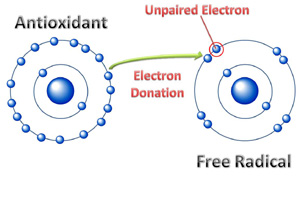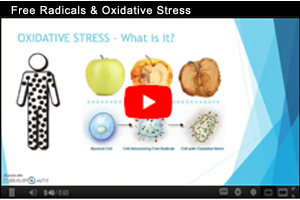
FREE RADICALS
 What are Free Radicals?
What are Free Radicals?
Free radicals are atoms or groups of atoms with an odd or unpaired number of electrons that forms when oxygen interacts with certain molecules.
Once formed these highly reactive radicals can start a chain reaction like dominoes.
The danger comes from the damage they can cause when they react with important cellular components like DNA or the cellular membrane.
Cells may function poorly or die if this occurs. To prevent this damage from free radicals, the body has a defense system of antioxidants.
A FREE RADICAL is an Atom that has lost it's Neutral Charge and is no longer stable. Because it now has a net + charge, it is looking for another atom nearby to steal a negative electron from in order to regain it's stability.
When this happens it creates yet another unstable atom and the effect starts to snowball. It will not be selective and will grab from anything it can find... since there are thousands
of times more healthy cells in our body than unhealthy ones, it usually takes from a healthy one thus causing a damagiing effect..
This is also known as the Rusting Process, also known as "Oxidative Injury" or "Reduction Reaction". An example of Free Radical Damage would be when you take an Apple and cut it open and within a few minutes it starts turning brown.
This is Oxidative Injury taking place. As oxygen interacts with cells of any type in your body oxidation occurs. This produces some type of change in those cells. They may die, such as with rotting fruit. In the case
of cut skin, dead cells are replaced in time by fresh, new cells and result in a healed cut.
This birth and death of cells in our body is going on continuously, 24 hours a day. This process that is necessary to keep the body healthy. Oxidation is a natural process that happens
during normal cellular functions.
However, while the body does metabolize oxygen quite efficiently, about 1 - 2 percent of our cells will get damaged during the process and become free radicals.
"Free Radicals", are missing a critical molecule which causes them to become very unstable and will roam "Freely" within the body, attacking any nearby cell attempting to replace
their missing electron. These molecules will steal a negative electron from any good healthy cell to fulfill that need in order to regain stability.
What is the Danger that Free Radicals Pose?
When free radicals attack, they don't just kill cells to steal the missing electron. Free radicals often cause injury to the cell damaging the DNA, which creates the catalyst for disease.
When a cell's DNA becomes altered, the cell will mutate. It grows and reproduces abnormally and very quickly. Normal cell functions will produce a small amount of free radicals, but free radicals are normally not a major concern as they are kept under control by antioxidants our body naturally
produces. However, it is important to keep those antioxidants well replentished by adding more leafy green vegetables to our diet. Thus, helping the body heal itself.
External toxins, like cigarette smoke, fuel exhaust and other forms of air pollution often create more Free Radicals. Cigarette smoke is a major source of free radicals. In fact, our
food and water also contain and inhibit the growth of free radicals in the form of pesticides and other toxins. Drinking excessive amounts of alcohol also triggers substantial free
radical production.
Free radicals trigger a chain reaction and this is where the problem lies. Free radicals don't just damage one molecule. When a free radical oxidizes a fatty acid, that fatty acid
looses an electron to the free radical and now becomes a free radical ITSELF since it is now missing a electron, which then damages another fatty acid. It's a very rapid chain of events.
These attacks can overwhelm the body's natural defense system. In time, and with repeated free radical
attacks that the body cannot stop, that damage can lead to a host of chronic diseases, including cancer, heart disease,
Alzheimer's disease, and Parkinson's disease.
Oxidative damage in skin cells is caused by cumulative sunlight. But if free radicals are in an internal organ - for example, if
asbestos is in your lungs -- it stimulates free radical reactions in lung tissue. Cigarette smoke has active free radical
generators. That's why stopping smoking is the biggest step anyone can take to preserving their health.
When this atom has stabilized itself it starts a chain reaction causing the atom it took the electron from to become yet another unstable atom. Now this atom has become a Free Racical and will look for another atom to steal an electron from.
This chain reaction soon gets out of control causing further damage and is taking place inside our bodies all the time.
However, Our body has a natural ability to produce it's own Antioxidants (Our Immune System) to protect itself but when the oxidative stress occurs sometimes when a high amount of free radicals are present in our body, it cannot creat enough antioxidants to combat this stress created by the Free Radicals.
For this reason we need to assist our body by giving it more antioxidants in order to reduce those Free Radicals.
There are numerous choices for antioxidant-rich foods, but which ones are really the best? The USDA tested over 100 foods from
all categories and developed an authoritative list of the top 20:
The Top 20 Foods Highest In Antioxidants
- 1. small red beans
- 2. wild blueberries
- 3. red kidney beans
- 4. pinto beans
- 5. cultivated blueberries
- 6. cranberries
- 7. artichokes
- 8. blackberries
- 9. prunes
- 10. raspberries
- 11. strawberries
- 12. red delicious apples
- 13. Granny Smith apples
- 14. pecans
- 15. sweet cherries
- 16. black plums
- 17. russet potatoes
- 18. black beans
- 19. plums
- 20. gala apples
Actually, One of the greatest Antioxidants in controlling Super Oxide Free Radicals is Sprouted Wheat Grass. Sprouted Wheat Grass is extremely powerful in pacifying the Free Radicals in our system. However, the Acai Berry is about 3 to 4 times as powerful in controlling the super oxide Free Radicals in our system..
Dried Fruits
With the water removed, the antioxidant ratio is higher in dried fruits than in fresh. They can easily be carried with you in
your purse, briefcase or car and they make a quick healthy snack. Consider taking along dried pears, plums, apples, peaches,
figs, dates and raisins.
Beverages
Contrary to popular belief, most of our antioxidants come from beverages. Apple juice, cider, tomato juice, pomegranate juice and
pink grapefruit juice seem obvious and green tea has become very popular as a source, but black tea and plain tea have high
levels also. Here's good news for those who love that cup of joe in the morning: coffee is high but should be consumed in
moderation. Note that adding milk to coffee or tea blocks antioxidants. Speaking of moderation, red wine and especially beer
(since it comes from grains) provide a big dose, and the healthy effects of moderate alcohol consumption have been well
documented.
Remember to eat a variety of fruits and vegetables in a myriad of colors. Don't just focus on the top 2 or 3 choices. Foods with
darker, richer colors like orange, yellow, blue, and red tend to be higher in antioxidants, and with all these choices, you'll
never become bored or run out of delicious, nutritious options. Variety is the spice of life.
|
|

|
|





